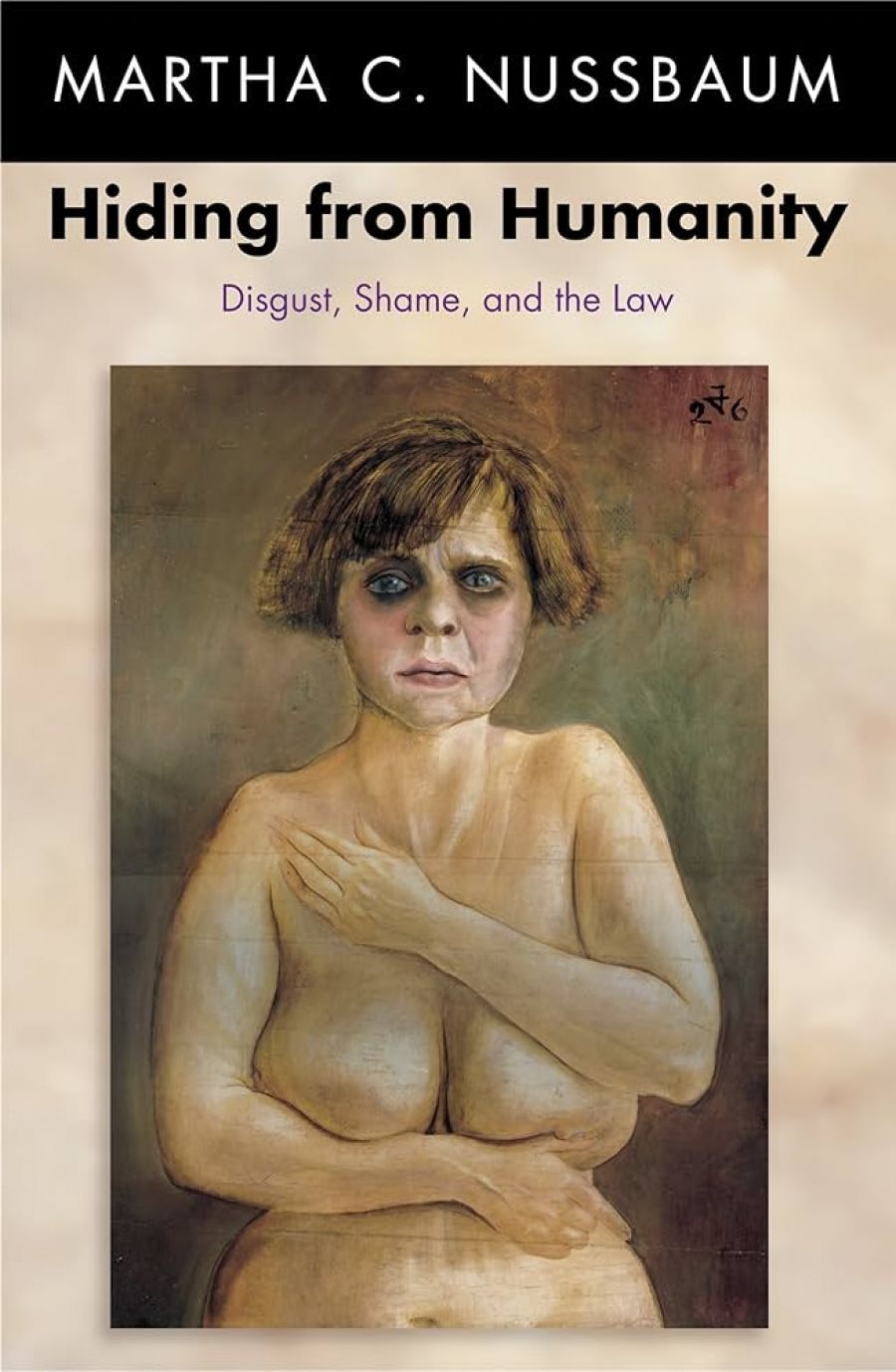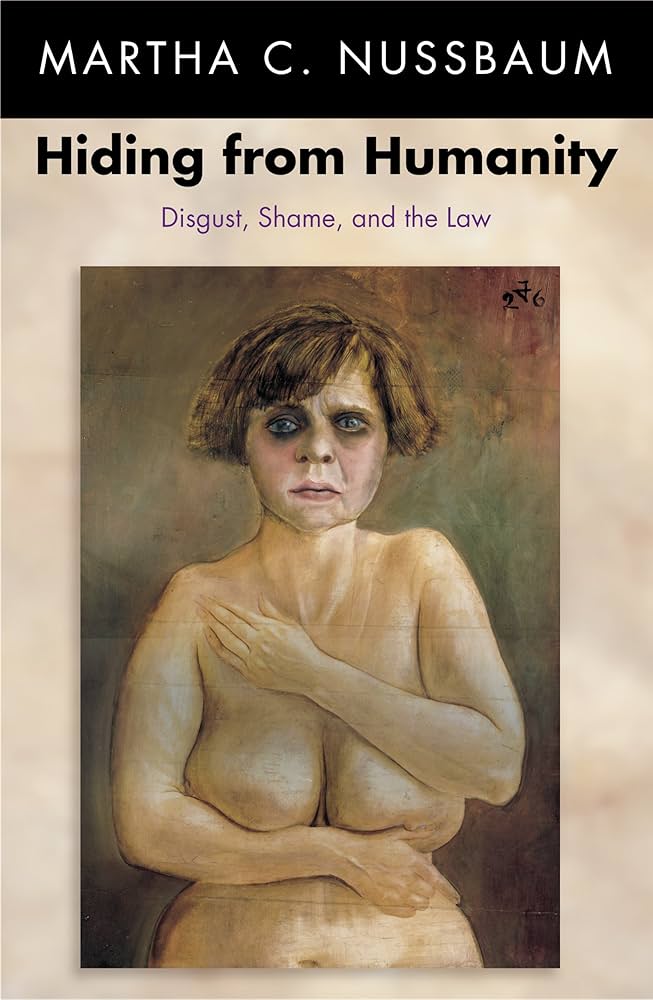
- Free Article: No
- Contents Category: Psychology
- Review Article: Yes
- Article Title: The Oozy Stuff
- Online Only: No
- Custom Highlight Text:
Martha Nussbaum is a distinguished contemporary philosopher who has written in exemplary fashion on ancient philosophy and philosophy of literature; she has also produced important work in social and political philosophy, philosophy of mind and feminist thought. This book on emotions, law and the idea of a liberal society shows some of the strain of that industry: it is prolix and a little uneven. But it also has the characteristics of her best work: sparkling clarity, high learning, intellectual vigour and something to say. The scope, the confidence – the grasp of it all – astonishes.
- Book 1 Title: Hiding from Humanity
- Book 1 Biblio: Princeton University Press, $29.95hb, 426pp
- Book 1 Cover Small (400 x 600):

- Book 1 Cover (800 x 1200):

Shame and disgust enter into law in a number of ways. Disgust is incorporated in the definition of obscenity, necrophilia and other proscribed sexual practices. Some contemporary conservative and communitarian thinkers have revived Lord Devlin’s famous argument that the law should fix the limits of the permissible by shielding society against any activity that disgusts the man on the Clapham omnibus. Disgust, one such thinker has said, is ‘the emotional expression of deep wisdom’. Disgust has also been invoked as mitigation: as when Stephen Carr happened to espy two lesbians making love, shot them and pleaded that disgust made him do it. Shame plays different roles. Most punishments induce shame and, if meted out publicly, usually a high degree of humiliation. Shame is also intimately, though variously connected with the transgression of community values. So some thinkers now argue for greater use of shaming penalties, which, they believe, would be effective deterrents and consolidate, or revive, shared community values. William F. Buckley Jr suggested that gay men with AIDS should have that information tattooed on their buttocks. For various offences, Dan Kahan favours branding the face.
It is probably indicative of our paranoically aggressive times that such outrageous measures are received as serious social policy proposals. Nussbaum does what philosophers usually do: she marshals a battery of objections. But here, unusually, she also belays her opponents’ motives. Powerful Millian considerations are directed against the notion that my neighbour’s disgust has any role in determining the sphere of my lawful activity; and Kantian considerations are brought to bear on the animus for shaming: shame, unlike guilt, which pertains to the wrongful act, targets the offender’s person and dignity: the undermining of human dignity through any means is strictly immoral. Nussbaum also observes perceptively that crime is often symptomatic of an already broken spirit and shaming can only make it worse.
However, the most interesting and novel arguments emerge from a different quarter. The lion’s share of the book is devoted to locating disgust, shame and their kin in the context of a sophisticated developmental psychology, and then tracing the social and political consequences of their infantile provenance. The psychology is largely psychoanalytic object-relations theory, and associated experimental and observational work. Nussbaum’s treatment of this material – specifically the views of Winnicott, Bollas, Goffman and others – and her integration of it, seem to me mostly accurate and fertile. The approach is rare in Anglo-American philosophy, though it has much to recommend it.
The gist of it is this. Disgust and (‘primitive’) shame – Nussbaum recognises a kind of constructive shame that impels towards the better – have primitive and irrational sources. Disgust, at bottom, is a reaction to decay and contamination, to the oozy stuff of which we are made, our animality. Anger and outrage, which are far more amenable emotions rationally, are appropriate responses to some crimes; the tendency inherent in disgust to treat criminals as if they were slugs or slime is not. Moreover, because we cannot easily confront our animality, we project the offending properties onto out-groups and stigmatise them. It is much the same with some shame. Primitive shame is a reaction to narcissistic wounds, and the reaction to such wounds is often irrational rage, the projection of the shame-bearing properties and the destructive wish to inflict shame on others.
Two important threads of the argument come into view here. On the one hand, disgust and shame are identified as (mostly) irrational emotions which engender stigmatisation and exclusion – of criminals, the poor, the disabled etc. – incompatible with a political dispensation based on equal respect and human dignity. Disgust and shame, it is concluded. are unreliable guides for framing law and social policy. On the other hand, Nussbaum highlights the (largely unconscious) aggressive and defensive motivations of those who promote shaming penalties and invoke disgust as a basis for legal discriminations. This last tack will cause discomfort. but is a valuable procedure all the same.
Half a century ago, G.E.M. Anscombe remarked that it was unprofitable to do moral philosophy in the absence of an adequate philosophy of psychology. This fine book shows something of what can be achieved in moral and social philosophy in the light of a rich, psychoanalytically informed moral psychology.


Comments powered by CComment